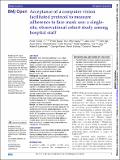Acceptance of a computer vision facilitated protocol to measure adherence to face mask use: a single-site, observational cohort study among hospital staff
Author(s)
Chai, Peter R; Rupp, Phillip; Huang, Hen-Wei; Chen, Jack; Vaz, Clint; Sinha, Anjali; Ehmke, Claas; Thomas, Akhil; Dadabhoy, Farah; Liang, Jia Y; Landman, Adam B; Player, George; Slattery, Kevin; Traverso, Giovanni; ... Show more Show less
DownloadPublished version (981.7Kb)
Publisher with Creative Commons License
Publisher with Creative Commons License
Creative Commons Attribution
Terms of use
Metadata
Show full item recordAbstract
<jats:sec><jats:title>Objectives</jats:title><jats:p>Mask adherence continues to be a critical public health measure to prevent transmission of aerosol pathogens, such as SARS-CoV-2. We aimed to develop and deploy a computer vision algorithm to provide real-time feedback of mask wearing among staff in a hospital.</jats:p></jats:sec><jats:sec><jats:title>Design</jats:title><jats:p>Single-site, observational cohort study.</jats:p></jats:sec><jats:sec><jats:title>Setting</jats:title><jats:p>An urban, academic hospital in Boston, Massachusetts, USA.</jats:p></jats:sec><jats:sec><jats:title>Participants</jats:title><jats:p>We enrolled adult hospital staff entering the hospital at a key ingress point.</jats:p></jats:sec><jats:sec><jats:title>Interventions</jats:title><jats:p>Consenting participants entering the hospital were invited to experience the computer vision mask detection system. Key aspects of the detection algorithm and feedback were described to participants, who then completed a quantitative assessment to understand their perceptions and acceptance of interacting with the system to detect their mask adherence.</jats:p></jats:sec><jats:sec><jats:title>Outcome measures</jats:title><jats:p>Primary outcomes were willingness to interact with the mask system, and the degree of comfort participants felt in interacting with a public facing computer vision mask algorithm.</jats:p></jats:sec><jats:sec><jats:title>Results</jats:title><jats:p>One hundred and eleven participants with mean age 40 (SD15.5) were enrolled in the study. Males (47.7%) and females (52.3%) were equally represented, and the majority identified as white (N=54, 49%). Most participants (N=97, 87.3%) reported acceptance of the system and most participants (N=84, 75.7%) were accepting of deployment of the system to reinforce mask adherence in public places. One third of participants (N=36) felt that a public facing computer vision system would be an intrusion into personal privacy.</jats:p><jats:p>Public-facing computer vision software to detect and provide feedback around mask adherence may be acceptable in the hospital setting. Similar systems may be considered for deployment in locations where mask adherence is important.</jats:p></jats:sec>
Date issued
2022-12Department
Koch Institute for Integrative Cancer Research at MIT; Massachusetts Institute of Technology. Department of Mechanical EngineeringJournal
BMJ Open
Publisher
BMJ
Citation
Chai, Peter R, Rupp, Phillip, Huang, Hen-Wei, Chen, Jack, Vaz, Clint et al. 2022. "Acceptance of a computer vision facilitated protocol to measure adherence to face mask use: a single-site, observational cohort study among hospital staff." BMJ Open, 12 (12).
Version: Final published version